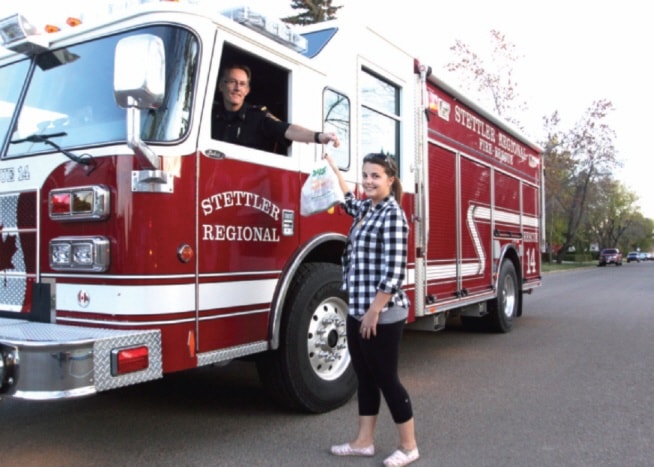S2014-10-08 for the annual fall food drive for the Stettler Food Bank.
Before the boxes and bags started to flow into the food bank, located at the United Church, the shelves in the food bank’s rooms were nearly empty. The back store room was barren as well.
“It’s the lowest I’ve ever seen,” one volunteer said as she rushed by, a box of food in her arms.
The fire department was joined by volunteers from ATCO, which sent out 10 trucks to take the food donations collected by the firefighters and run them back to the church. There, an army of volunteers from the food bank, the Church of Latter Day Saints, Heartland Youth Centre, and members of the community – including several who have had to turn to the food bank for assistance – marched the boxes, crates and bags full of food inside and sorted them for quick storage downstairs.
According to Birch, the local grocery stores have been great assistance to the food bank, donating baked goods for distribution. Money donated to the food bank goes to paying for things like milk, margarine, and other staple products that the food bank runs short on.
One thing Birch said she hopes to see in donation bins is coffee.
“Most people like to have their cup of coffee in the morning,” she said.
Even instant coffee can be out of reach for people relying on a food bank to help keep bellies full, and as it’s not a staple food, the food bank itself won’t purchase it. But having it and being able to give it out to people in need is something that is always warmly received, Birch said.
On average, each family that comes to the food bank for help receives five bags of groceries, an estimated value of $117. Most only come once a month, but some families are in such tight times that they will come more than once.
“It’s not an easy thing for people to do,” Birch said.
When the Independent went to the food bank on Tuesday to interview volunteers, there were several people present, all of different ages, sexes and ethnicities.
None would speak to the paper, even anonymously, about the experience.
“It really hurts to have to go for help,” Birch said.
Though the shelves at the food bank are full, there are some items the food bank could still use to help round out the hampers provided to people in need.
“Healthy food is the most important,” she said. “While everyone, even people relying on food banks for help, deserves treats, there’s only so many meals one can make out of a treat.”
Food like canned fruit and vegetables, non-sugary cereals, and basic meal staples make the best donations.
Right after that come food items that can be made into kids’ lunches.
“Cheese spread is so expensive, and we didn’t get a lot of it (during the drive),” Birch said. “But it’s so popular and it’s great for lunches.”
She also said juice boxes would be a useful addition to the food bank’s larder.
“Complement foods” are also needed. These foods round out a meal, and often when people are donating food they don’t think about what they’d need if they were making that for a meal themselves.
Spaghetti and pancake mix make good examples of a need for complement foods. Both are frequently donated, but spaghetti sauce or syrup less often.
“We find ourselves buying spaghetti sauce,” Birch said.
It’s still possible to donate to the food bank, either at local grocery stores or at the food bank itself.
Though Birch said the shelves won’t be bare by Christmas, the volunteers will be needing to purchase food to augment shortcomings.
The final thing Birch suggested when trying to decide what type of food to donate is a very simple question.
“Would I eat this?”
Healthy food is hard to buy
For families on a tight budget, the quality of food coming into the home suffers. It’s often less expensive to buy cheap, processed food rather than fresh produce and longer-to-cook meals, and health can suffer.
Statistics show that people in a low-income situation have higher incidents of obesity, Type II diabetes, and heart-health issues that are rooted in the food they eat.
When people donate food like cake mixes or sugary cereals donate these items to food banks, they do it with good intentions, according to the Put Food in the Budget, a grassroots organization that tries to draw attention to the cost of living when it includes healthy food.
The problem is these less healthy treats can come to make up an unhealthy proportion of a family’s meal, especially if the family is especially reliant on a food bank for meals.
It doesn’t help that so many of the foods that are non-perishable are high in carbohydrates.
Statistics from the University of Alberta reveal that one of the first costs a family slashes in the face of rising expenses and lower income is food. It starts with eating out but the cuts can go even deeper.
Healthy food donation ideas
Meat & Protein
Canned tuna
Canned salmon
Canned ham
Brown beans
Lentils
Vegetables & Fruit
Canned-in-water fruit
Low-sodium canned vegetables
Vegetable soups and chilis
Spaghetti sauce
Grains
Saltine crackers
Non-sugary cereals
Flour
Dairy
Cheese spread
Other
Instant coffee
Tea
Mustard
Mayonnaise
Ketchup
Sugar
Toilet paper
Tooth paste
Toothbrushes
Floss
Feminine hygiene products
Syrup
